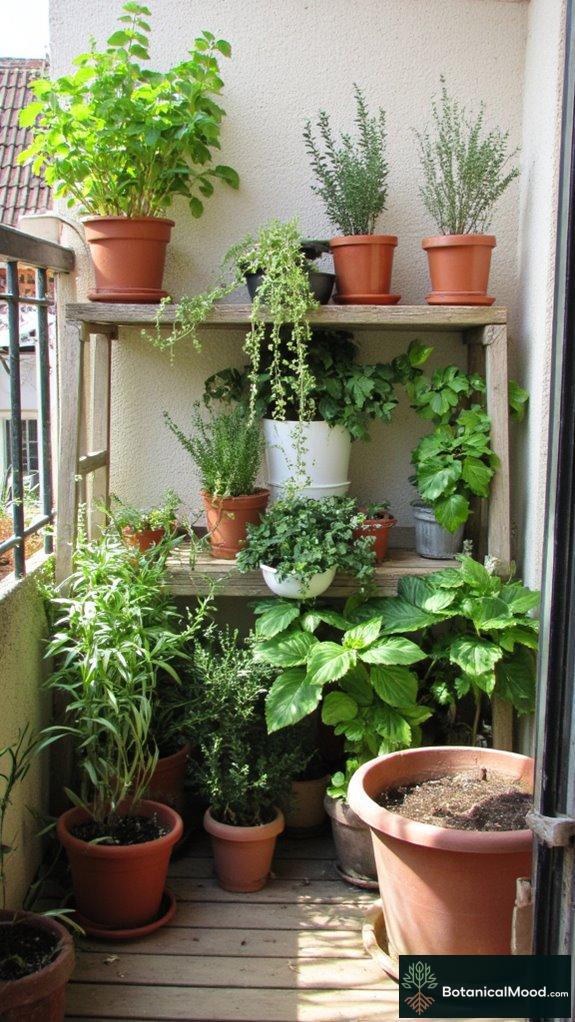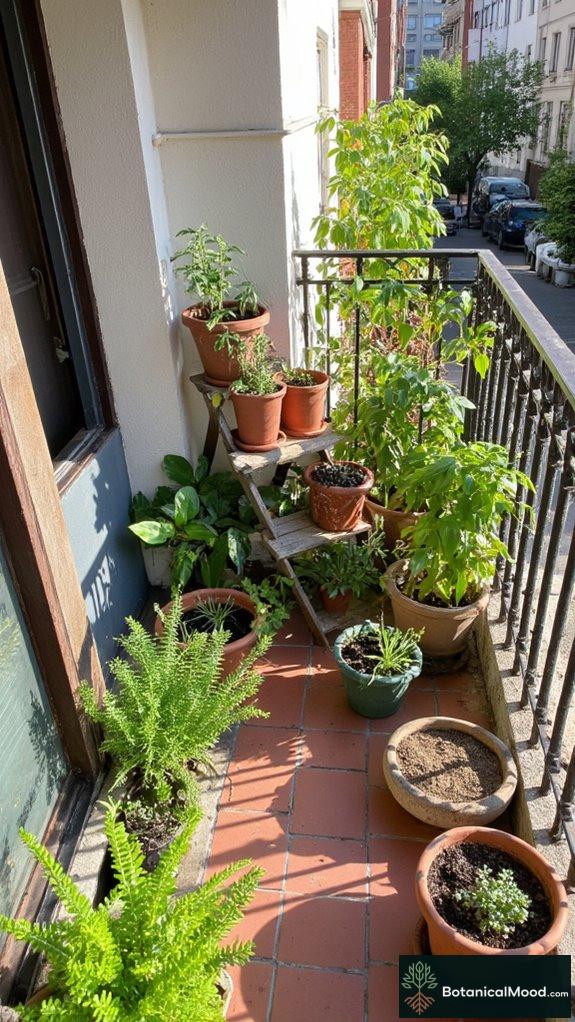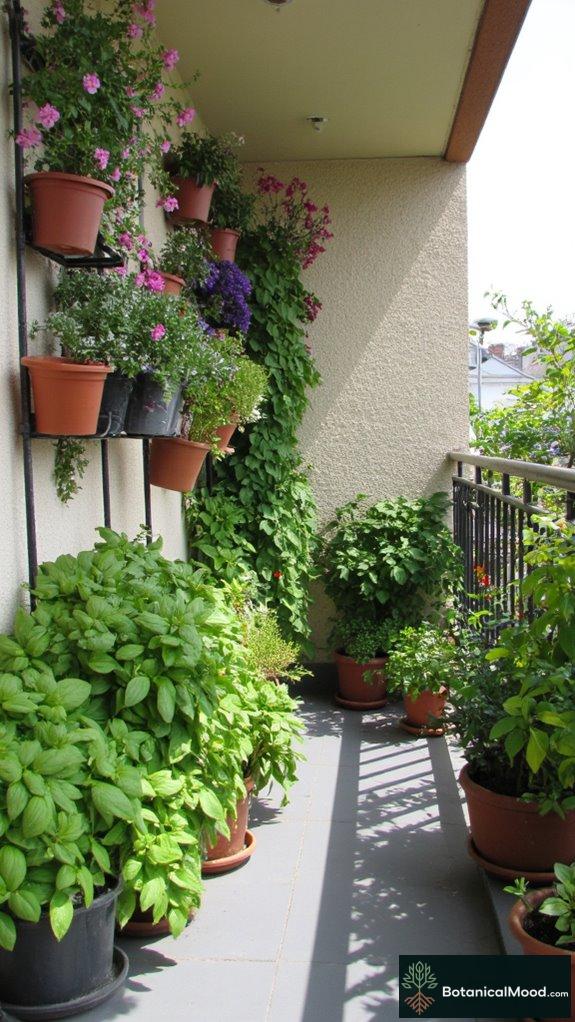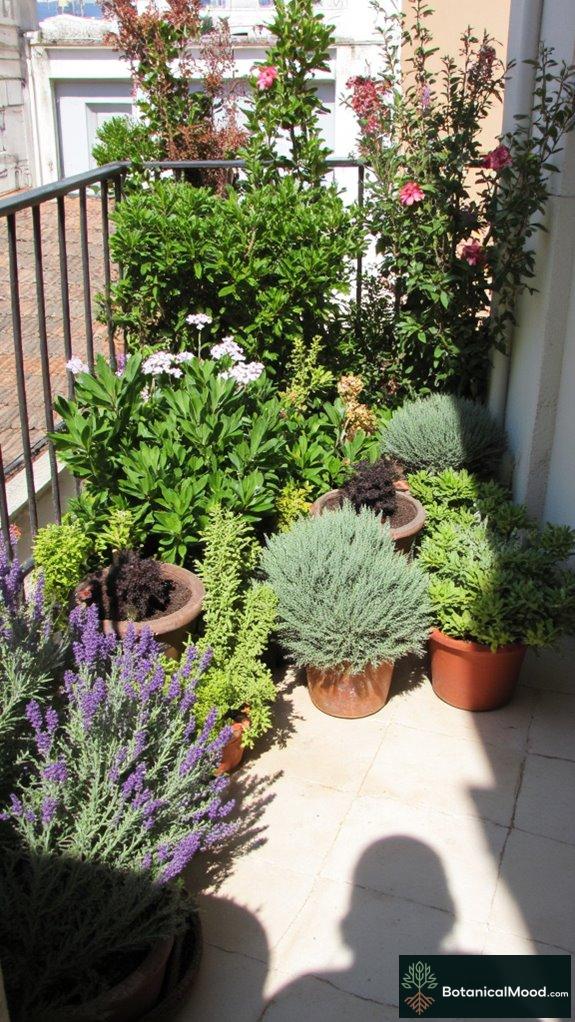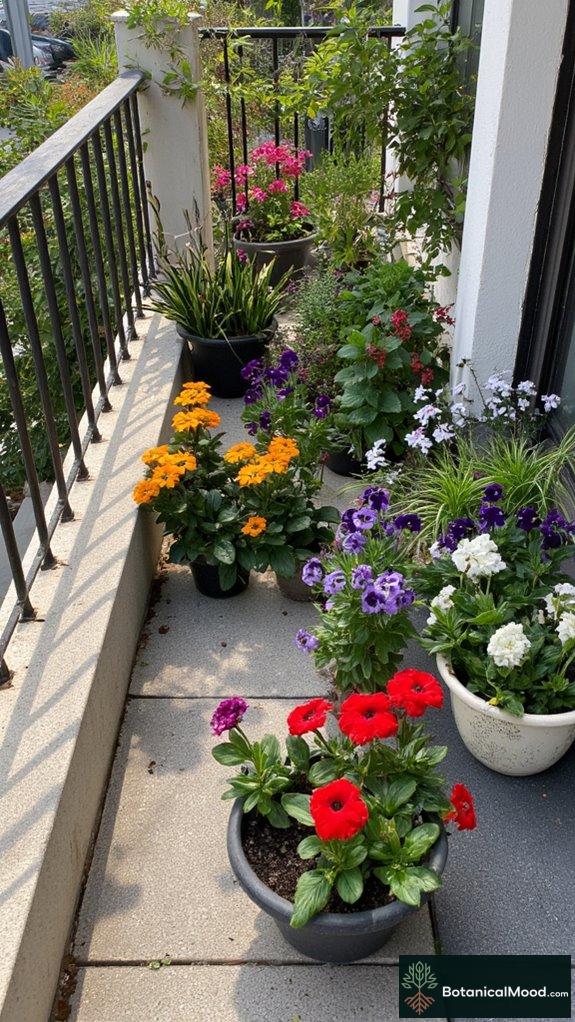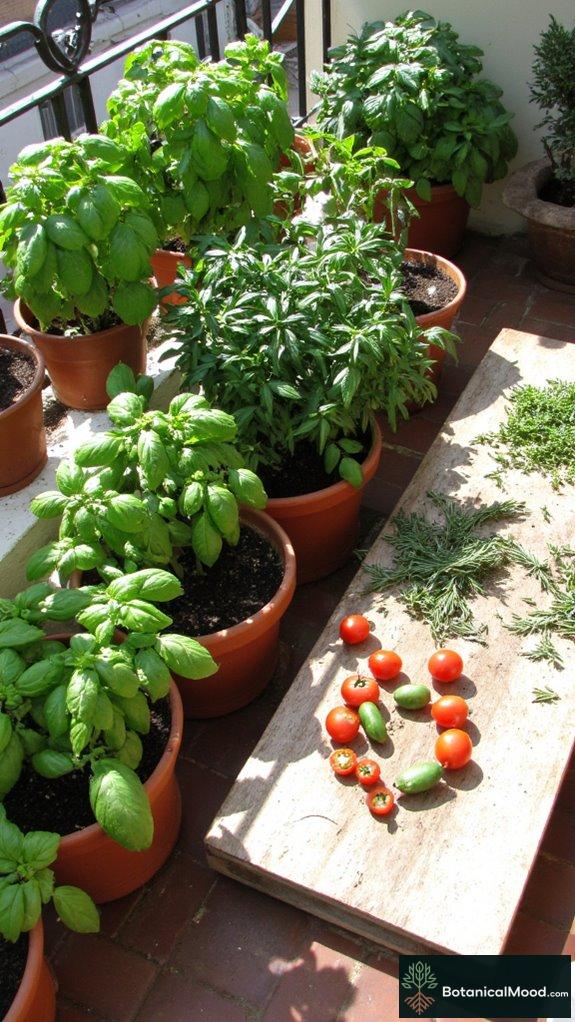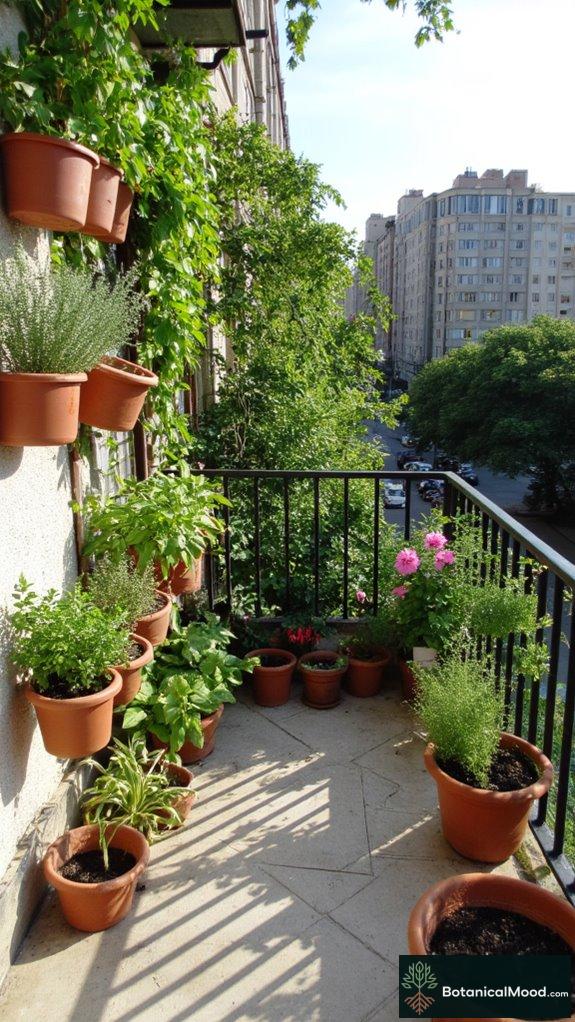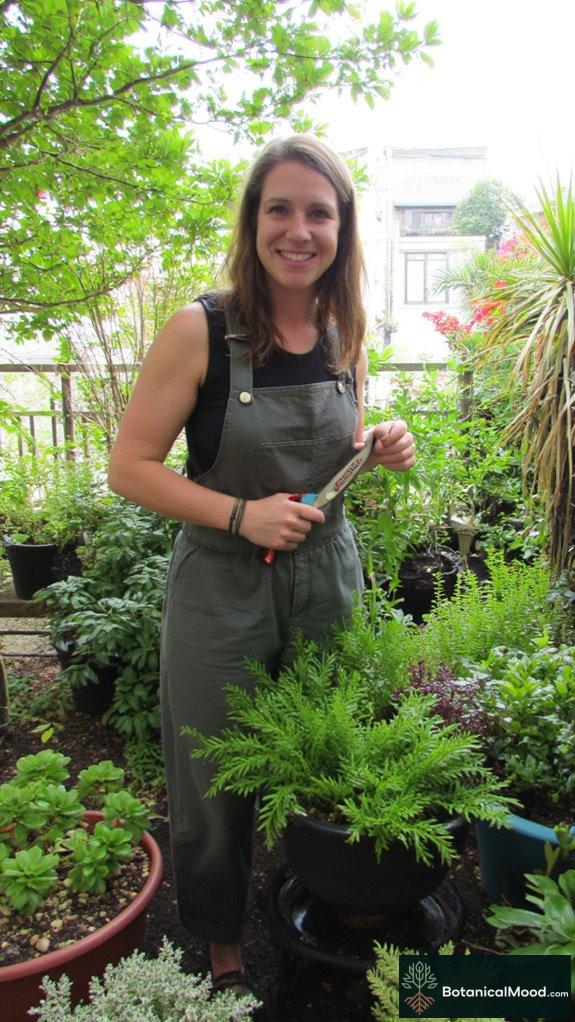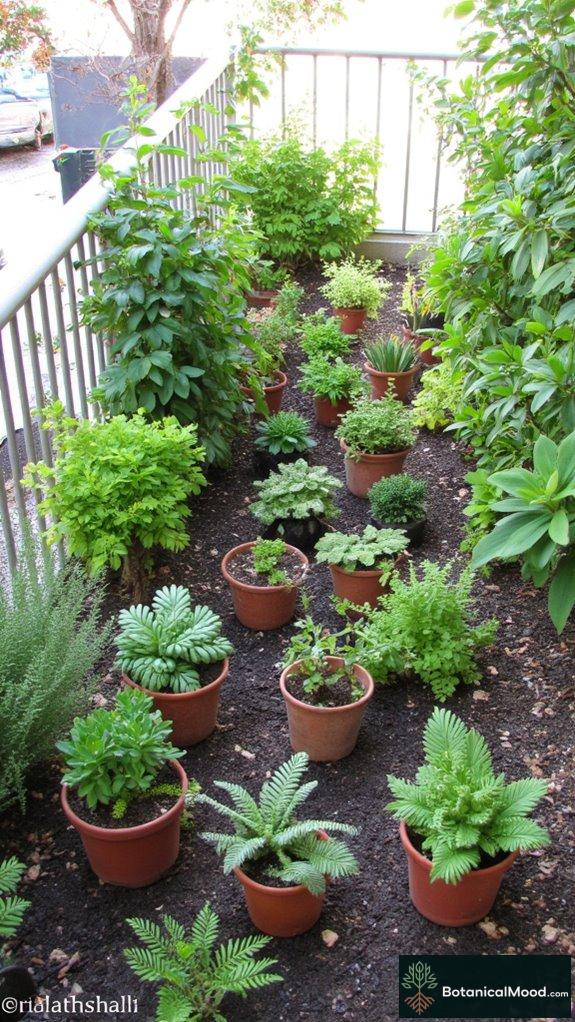I never thought I could turn my cramped apartment into a green sanctuary, but vertical gardens saved the day!
By hanging planters and trellises on my walls, I suddenly had a mini jungle without losing precious floor space.
Pothos and English Ivy flung themselves into action, giving life and color to my dull walls. And let’s be honest, I’m no gardener – I need all the help I can get.
Thank goodness for brands like Grovert and their self-watering systems; they practically do the work for me!
Who knew plants could improve air quality and make my place look fancy?
Designing My Vertical Garden: A Personal Journey
I remember the first time I tried to set up a vertical garden—my wall looked like a botanical crime scene. After countless Pinterest fails, I finally figured out the right plant placement for maximum sunlight.
A mix of trailing and cascading plants not only created depth but also added surprise pops of color.
It was a learning curve—but oh, the joy of those vibrant greens now gracing my walls!
And here’s a pro tip: make sure to consider your light sources; certain plants prefer bright spots, while others might thrive in the shade.
Trust me, trial and error is key (and sometimes hysterical). Embrace the chaos!
Quick Takeaways
- Vertical gardens utilize wall-mounted planters and trellises to maximize limited space while enhancing aesthetic appeal.
- Incorporate climbing and trailing plants like Pothos and English Ivy to create lush, inviting environments in compact areas.
- Select low-maintenance species such as Sansevieria and utilize automated watering systems for effortless care and hydration.
- Engage the community through workshops and volunteer programs to foster interest and participation in urban green initiatives.
- Future trends include smart irrigation systems and modular designs that optimize space for diverse plant cultivation in urban settings.
Maximizing Vertical Space for Garden Efficiency

When space is tight, it’s essential to think innovatively about how we use vertical planes to enhance our gardening experience. Vertical growth is key to maximizing space utilization in compact areas, allowing me to cultivate lush greenery without sacrificing precious floor space. By incorporating wall-mounted planters, trellises, or living wall systems, I can showcase stunning plants like Echinacea purpurea or cascading ferns, enriching my environment aesthetically. Clever arrangements or color choices create visual interest while ensuring every inch contributes to the overall garden design. Additionally, utilizing wall-mounted planters can provide a functional yet artistic way to display plants and optimize limited space. Combining function with artistry, I invite you to explore how vertical gardening can transform your space into an intimate urban oasis.
Ideal Plants for Indoor Vertical Gardens

Exploring the world of indoor vertical gardens introduces a delightful array of plant possibilities, especially since choosing the right species can elevate your indoor space both visually and atmospherically.
For a successful vertical garden, consider climbing plants like Epipremnum aureum (Pothos) and Hedera helix (English Ivy). Their trailing nature makes them perfect for cascading down lightweight containers.
You’ll appreciate how easily these plants adapt to different light conditions.
Integrating various foliage types, like ferns or orchids, adds texture and depth. By selecting these vibrant options, you’ll create a lush, inviting environment that enhances your daily living experience, making your indoor oasis truly yours. Moreover, implementing diy vertical gardening techniques can significantly enhance the overall aesthetic appeal and functionality of your space.
Designing a Living Wall: Aesthetic Considerations

How can I transform a simple wall into a vibrant living canvas?
By thoughtfully selecting color palettes and texture combinations, I can create stunning visual interest. I often play with harmonies and contrasts to enhance my living walls.
Here’s a simple guide to help:
| Color Palette | Texture Combination | Suggested Plants |
|---|---|---|
| Monochromatic | Smooth, Spiky | Ficus elastica, Aloe vera |
| Complementary | Soft, Rough | Sedum morganianum, Ferns |
| Analogous | Varied, Layered | Pothos, Ivy |
With keen attention to detail, I design gardens that not only captivate the eye, but also bring my spaces to life.
Year-Round Seasonal Color Choices

Incorporating seasonal color choices into my vertical gardens breathes life into these living walls all year long, ensuring that every corner of my space maintains its charm regardless of the season.
A carefully curated selection of seasonal palettes and color combinations can evoke feelings of tranquility or vibrancy, transforming the atmosphere.
I recommend considering:
- Spring: Bright yellows and soft pastels (e.g., *Viola tricolor*).
- Summer: Bold reds and deep greens (e.g., *Petunia* hybrids).
- Autumn: Warm oranges and russet tones (e.g., *Aster novae-angliae*).
- Winter: Cool blues and evergreens (e.g., *Ilex aquifolium*).
This thoughtful approach enhances my urban oasis beautifully.
Eco-Friendly Benefits of Vertical Gardens
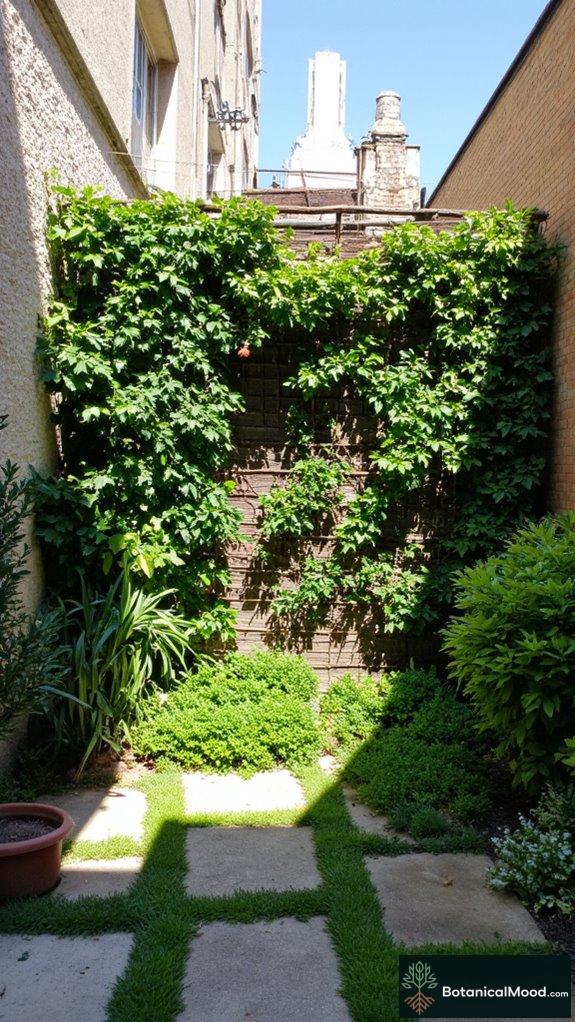
As I explore the world of vertical gardens, it’s evident that their eco-friendly benefits extend far beyond mere aesthetics; they actively contribute to a healthier urban environment.
By integrating sustainable design principles, vertical gardens—like those featuring Ficus pumila or Sedum spp.—enhance air quality considerably, filtering pollutants and increasing oxygen levels.
These living walls not only sequester carbon but also reduce urban heat, promoting biodiversity in compact areas. Oftentimes, I’ve noticed these gardens mitigate stormwater runoff, allowing for efficient water management in cities.
Ultimately, embracing vertical gardens empowers us to reclaim our urban environments while nurturing our planet.
Sound Absorption and Temperature Regulation

While the aesthetic allure of vertical gardens is undeniable, their sound absorption and temperature regulation properties truly enhance urban living.
- The plants’ foliage acts as a barrier, providing acoustic benefits that reduce noise pollution.
- Heat is moderated by the evapotranspiration process, creating a rejuvenating microclimate.
- Vertical gardens, like those featuring Ficus pumila or Hedera helix, serve as effective shields against harsh weather, contributing to climate control.
- A well-designed garden can lower indoor temperatures by up to 10 degrees, proving beneficial for energy savings.
Vertical Gardening Techniques for Small Spaces

Creating a vertical garden in a compact space not only enhances the beauty of your surroundings, but it also maximizes the use of limited real estate, turning even the smallest balconies or walls into vibrant living tapestries.
To achieve this, consider employing innovative installations such as modular planters or wall-mounted racks.
Explore creative options like modular planters and wall-mounted racks to transform your space into a vertical garden oasis.
Utilizing space-saving structures, like trellises combined with climbing plants, allows you to optimize your vertical space effortlessly.
Select hardy, low-maintenance plants, such as Sedum (Sedum spp.) or trailing vines like Pothos (Epipremnum aureum), that thrive in restricted environments.
With careful planning, you’ll craft a stunning vertical oasis tailored to your lifestyle.
Simplifying Maintenance for Indoor Gardens

Maintaining an indoor garden can be deceptively straightforward, especially when you leverage a few strategic practices that simplify the process.
- Choose Low-Maintenance Plants: Opt for resilient species like Sansevieria (Snake Plant) or Zamioculcas zamiifolia (ZZ Plant).
- Automate Water Management: Use self-watering systems or moisture meters to guarantee consistent hydration.
- Invest in Quality Maintenance Tools: Essential items like pruning shears and a moisture meter can enhance control.
- Routine Checks: Schedule regular inspections to catch pests early and adjust conditions.
With these practices, I feel more connected to my green oasis, translating effort into beauty.
Visual Inspiration: Transforming Urban Spaces

Urban environments often possess untapped potential for beauty through the thoughtful integration of vertical gardens. By embracing vertical garden aesthetics, we can create lush, vibrant spaces that elevate our urban experiences. Each carefully selected plant—like Ficus pumila or Plectranthus verticillatus—adds texture and harmony, instilling tranquility amidst the concrete jungle.
Urban green initiatives frequently spark inspiration, transforming bland facades into spectacular living walls that invigorate communities. Picture a bustling city street adorned with cascading greenery, thriving against urban chaos.
These designs ultimately reflect our desire for control over our surroundings, allowing us to craft serene oases and elevate the beauty of our spaces.
Innovative Brands Leading the Vertical Gardening Trend

In 2023, the impact of such brands extends beyond aesthetics; they champion environmental consciousness and enhance air quality, creating a symbiotic relationship between nature and urban life.
In 2023, these brands redefine urban living by promoting sustainability and improving air quality through innovative vertical gardening solutions.
Here are four innovative brands leading the vertical gardening trend:
- Green Wall Company – Focuses on sustainable practices, supplying modular living walls that thrive in various climates.
- Vertical Gardens – Features customized vertical gardens designed to suit urban settings, enhancing both visual appeal and biodiversity.
- Grovert – Offers innovative designs in self-watering systems that simplify maintenance.
- Grove Vertical Garden – Promotes ease of use with excellent drainage, ensuring plants like Spathiphyllum (peace lily) flourish effortlessly.
Community Engagement in Urban Green Projects

Engaging communities in urban green projects not only revitalizes cityscapes but also fosters a sense of ownership and belonging among residents. By organizing community workshops and public engagement events, we nurture local partnerships that amplify awareness campaigns focused on sustainability efforts.
| Initiative Type | Description |
|---|---|
| Community Workshops | Hands-on sessions for skills building |
| Volunteer Programs | Opportunities to participate directly |
| Educational Outreach | Programs emphasizing urban agriculture and horticultural therapy |
Through these initiatives, we cultivate enthusiasm for green initiatives and empower residents to actively shape their environment, creating vibrant vertical gardens that reflect shared values.
Overcoming Challenges in Vertical Garden Implementation

While many might view vertical gardens as an innovative solution for limited spaces, the path to successful implementation often presents numerous challenges that require careful navigation.
To effectively address these hurdles, I focus on:
- Space limitations: Analyzing your chosen wall or surface for adequate planting area is essential.
- Structural support: Ensuring that fixtures can bear the weight of soil and plants prevents disasters.
- Watering systems: Choosing a reliable irrigation method is crucial for maintaining healthy foliage.
- Plant selection: Opting for suitable species like *Ficus pumila* allows for vibrant displays with manageable maintenance.
Future Trends in Vertical Gardening Solutions

As urban environments continue to evolve, the trend towards vertical gardening solutions is set to flourish, especially in compact spaces where traditional gardening isn’t feasible.
With advancements in smart irrigation systems and modular designs, I can see a future filled with opportunities for urban agriculture.
By integrating technology, we achieve sustainable design that accommodates passive designs essential for space optimization.
The precision of plant selection allows us to cultivate diverse species like herbs and succulents in limited areas.
As I explore tech innovations, I understand how these solutions empower us to take control of our greenery, making gardening a viable option even in the smallest urban settings.
Vertical Garden Aesthetics
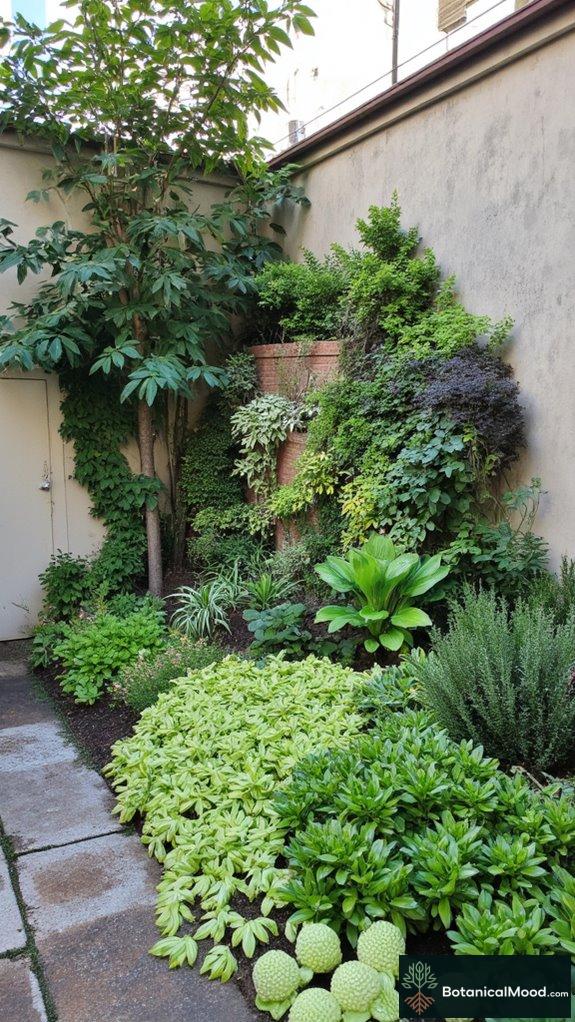
There’s a certain magic in the way vertical gardens transform urban surroundings, breathing life and color into otherwise stark environments.
- Color dynamics can range from harmonious tones to bold contrasts, allowing for greater visual impact.
- Textural variety through differing leaf shapes and sizes generates depth.
- Plant layering maximizes seasonal contrast, ensuring year-round visual engagement.
- Design principles like unity and balance unify plant species while enhancing urban integration.
Vertical Greening Strategies

Vertical gardens go beyond aesthetic appeal; they embody innovative greening strategies that maximize limited space in urban environments and enhance biodiversity. Engaging in vertical gardening allows me to utilize modular systems like trellises (for crops such as Phaseolus vulgaris) or hanging planters for culinary herbs and trailing vegetables.
I appreciate how pallet planters and upcycled fabric organizers create sustainable, customized slots for cultivation. Additionally, A-frame and arch trellises amplify growing areas, efficiently managing airflow and moisture control.
Each carefully selected plant not only enriches the environment but also brings a sense of accomplishment and sustainability to my compact urban oasis.
Meet the Garden Curator

Jessica Mitchell, from Portland, Oregon, discovered her passion for vertical gardens after transforming her tiny balcony into a lush green retreat, inspiring her desire for a more immersive garden experience.
To design her enchanting vertical garden, Mitchell engaged in extensive research on plant compatibility and space optimization. She collaborated with a local outdoor designer and attended workshops on vertical gardening techniques, ensuring her vision was both practical and aesthetically pleasing.
Mitchell utilized tools such as the Green Wall System from LiveWall and accessories like the Vertical Garden Planters from Gardener’s Supply Company.
Partnering with horticulturist Jodie Franklin, she meticulously selected plants suitable for her garden’s microclimate.
Urban Space Gardening Techniques

When exploring urban space gardening techniques, one quickly realizes that maximizing limited areas requires creativity and innovative approaches.
My favorite methods include:
- Container gardening: Perfect for indoor planting, it allows for flexibility and mobility, accommodating any compact design.
- Vertical gardening: Utilizing walls can transform any space into a lush escape while limiting ground area use.
- Raised beds: They elevate plants, protecting them from contaminated soil.
- Hydroponic systems: Soil-less growing is ideal for urban settings with poor soil quality, ensuring consistent nutrient access.
Adopting these strategies can help anyone transcend spatial limitations and cultivate a thriving urban oasis.
Summary
Creating a vertical garden has turned my small space into a vibrant retreat. With the right plants like spider plants and peace lilies, I’ve brought a touch of nature into my urban life. It’s amazing how a living wall can rejuvenate a concrete environment.
I’d love to hear about your experiences with vertical gardens! How have they transformed your spaces?
Feel free to share photos of your own garden and tell us about your design journey!
References
- https://risegardens.com/blogs/communitygarden/vertical-farming-s25
- https://www.unsustainablemagazine.com/vertical-gardening-in-cities/
- https://www.precedenceresearch.com/vertical-garden-construction-market
- https://zerowastefamily.com/vertical-gardens-grow-more-in-a-small-space
- https://www.lsuagcenter.com/articles/page1717696392923
- https://www.edengreen.com/blog-collection/what-is-vertical-farming
- https://willowalexander.co.uk/howa-living/vertical-garden-design-living-walls-for-urban-spaces/
- https://gardenerswoodfordgreen.org.uk/blog/the-aesthetic-appeal-of-vertical-gardens
- https://green.org/2024/01/30/vertical-gardens-balancing-aesthetics-and-functionality/
- https://deepgreenpermaculture.com/2025/04/05/the-10-principles-of-aesthetic-garden-design-a-comprehensive-guide-to-creating-beautiful-and-harmonious-spaces/
- https://aspirefinehomes.com/mastering-upscale-garden-design-a-guide-to-luxury-outdoor-spaces/
- https://gardenershillingdon.org.uk/blog/urban-aesthetics-and-functionality-with-vertical-gardening
- https://www.theinteriordesigninstitute.com/au/en/the-rise-of-biophilic-design-bringing-nature-indoors
- https://altogarden.com/blog/vertical-vegetable-garden-for-small-spaces/
- https://brumargardens.com/5-transformative-planting-techniques-for-compact-spaces-from-bru-mar-gardens/
- https://dug.org/gardening-resources/vertical-growing/
- https://wholemadehomestead.com/vertical-gardening-for-small-spaces/
- https://www.youtube.com/watch?v=yGOFBeBw3k8
- https://www.bigskylandscapes.com/vertical-gardening-solutions-for-urban-and-limited-spaces/
- https://joegardener.com/podcast/small-space-vegetable-gardening-mark-ridsdill-smith/
- https://www.frontiersin.org/journals/sustainable-food-systems/articles/10.3389/fsufs.2022.997081/full
- https://bluestem.ca/uncategorized/urban-gardens-are-thriving-despite-city-pollution-new-research/
- https://www.winssolutions.org/sustainable-urban-gardening-in-the-city-enhancing-urban-life/
- http://www.climatehubs.usda.gov/hubs/international/topic/urban-agriculture
- https://www.epa.gov/brownfields/urban-agriculture
- https://agupubs.onlinelibrary.wiley.com/doi/10.1029/2022EF002748


